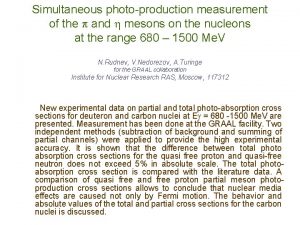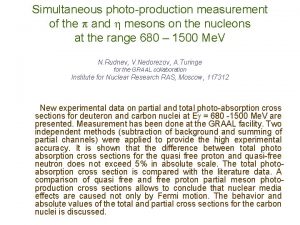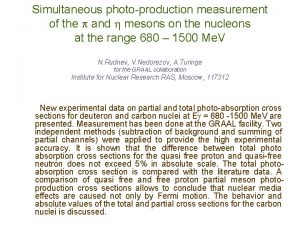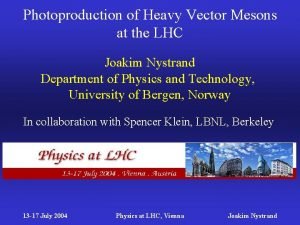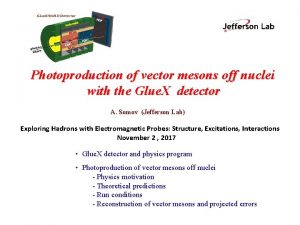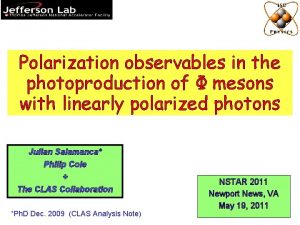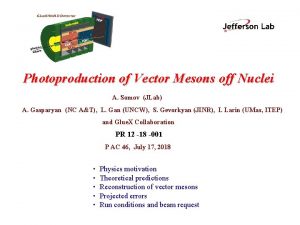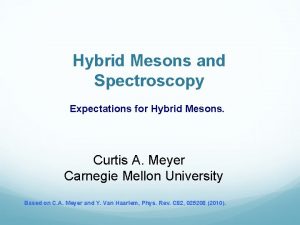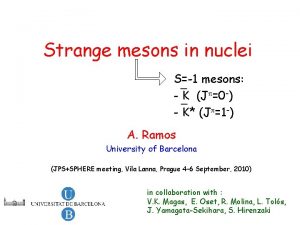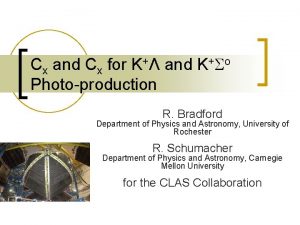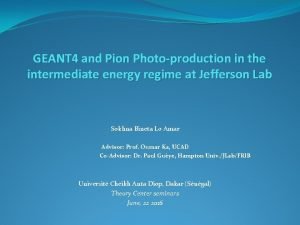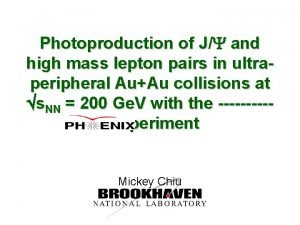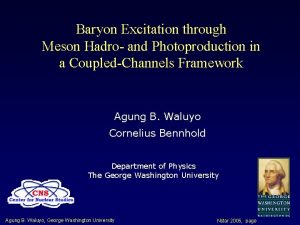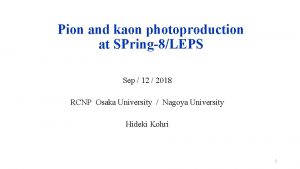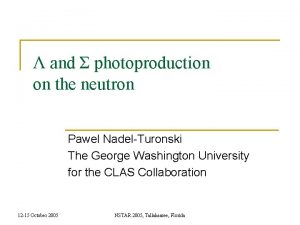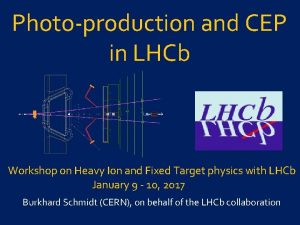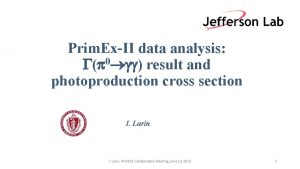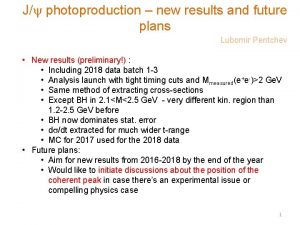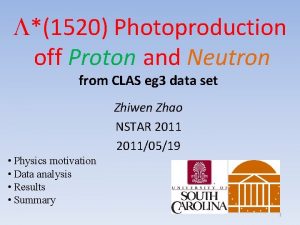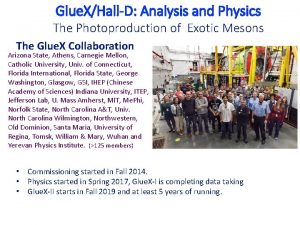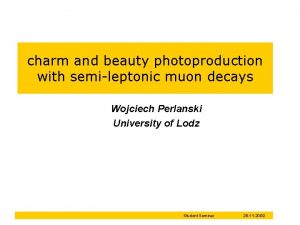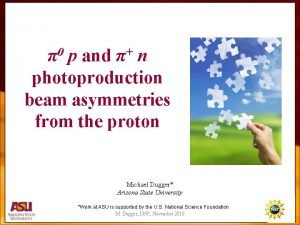Photoproduction of h and h Mesons on the









































- Slides: 41

Photoproduction of h and h‘ Mesons on the Nucleon L. Tiator, Institut für Kernphysik, Universität Mainz v introduction v the MAID project v t-channel exchanges: poles vs. Regge trajectories v D 15(1675) resonance vs. P 11(1675) pentaquark v summary and conclusion

p threshold K threshold nonresonant background: large very small large




motivation for g, and g, ‘ • missing or misidentified resonances • qqq resonances vs. dynamically generated resonances with pp. N or with KS, e. g. S 11(1535) • exotic resonances: Does the Q+ pentaquark exist? if so, it should have a non-strange partner P 11(~1700)

MAID the Mainz-Dubna Unitary Isobar Model K-matrix unitarization phase determined by the Watson theorem, below 2 p threshold relaxed above 2 p threshold

ETA-MAID uses a simpler approach without additional unitarization:

Resonances Breit-Wigner form 8 resonances are included in -MAID : D 13(1520) S 11(1535) S 11(1650) D 15(1675) very important for S most important very important for S F 15(1680) less important D 13(1700) unimportant P 11(1710) important P 13(1720) unimportant

Background Born Terms very small coupling constant:

Vector Meson Exchanges

This description for vector meson exchanges § works fine in the resonance region (W < 2 Ge. V) § but cannot be extended to high energies

Regge Trajectory Exchanges At high s and low t, it is known that meson photoproduction can be well described by Regge trajectories in the t-channel. Replace pole-like propagator With Regge propagator

Vector Meson Exchanges in p hp Fit high-s, low-t data to determine the vector meson couplings g. VNN and k. VNN Data from DESY (1970)

Photoproduction Data available in 2001 Cross sections • MAMI in Mainz Krusche et al. , Phys. Lett. B 358, 40 (1995) • ELSA in Bonn Price et al. , Phys. Rev. C 51, 2283 (1995) • GRAAL, ESRF in Grenoble Renard et al. , Phys. Lett. B 528, 215 (2002) MAMI 95 ELSA 95 GRAAL 02 Beam asymmetry • GRAAL, ESRF in Grenoble Ajaka et al. , Phys. Rev. Lett. 81, 1797 (1998) Kouznetsov (SAID database) GRAAL 98 GRAAL 01 Target asymmetry • PHOENICS, ELSA in Bonn Bock et al. , Phys. Rev. Lett. 81, 534 (1998) ELSA 98

Photoproduction Data after 2001 Cross sections • GRAAL, ESRF in Grenoble Renard et al. , Phys. Lett. B 528, 215 (2002) • CLAS, Jefferson Lab Dugger et al. , Phys. Rev. Lett. 89, 222002 (2002) • CB-ELSA in Bonn Crede et al. , Phys. Rev. Lett. 94, 012004 (2005) GRAAL 02 CLAS 02 BONN 05 preliminary data 2005/06 Cross sections and Beam Asymmetry • GRAAL (ds/d. W and S for proton and neutron) Kouznetsov et al. , N*2005 GRAAL 05 • CB-ELSA (s and ds/d. W for proton and neutron) Jaegle et al. N*2005 BONN 05

Eta-Maid 2001 compared to data from TAPS@Mainz and GRAAL differential cross section photon beam asymmetry

Comparison with the Eta-Maid 2003 Reggeized Model

with std. vector meson poles and hadronic form factors with reggeized vector mesons both models describe very well the proton data

standard w, r + resonances reggeized w, r only reggeized w, r + resonances

The role of the D 15(1675) resonance h. N branching ratios in our 2 models: 17 % for the Eta. Maid with v. m. poles 0. 7 % for the reggeized model

! almost a factor 10

Comparison with preliminary data from GRAAL diff. c. s. and beam asymm. on neutron (priv. comm. S. Kouznetsov, 2006) bump observed around 1650 Me. V -Maid 2001 -Maid without D 15

Comparison with preliminary data from CB-ELSA total c. s. on proton and neutron (I. Jaegle, priv. comm. 2006) - Maid 2001

ETA - MAID 2003 isobar model (update of Eta-Maid 2001) reggeized isobar model (w, r Regge trajectories) (preliminary data from CB-ELSA, I. Jaegle, priv. comm. 2006) only the model with the strong D 15 can describe the neutron data

problems with the D 15(1675) resonance: 1) in the std Eta. Maid model it fits the neutron data very well but needs a large branching ratio of b N = 17 % SU(3)fl for baryon octett gives a prediction of b N= 2. 5 % (Guzey and Polyakov, hep-ph/0512355) 2) in the Regge model the D 15(1675) does not play any important role



effect of a non-strange pentaquark in


quasifree eta photoproduction on the deuteron in collaboration with Alexander Fix ( e. g. A. Fix and H. Arenhövel, Z. Phys. A 359 (1997) 427 ) in impulse approximation: h. NN fsi is negligible NN fsi is larger but only important near threshold input: Eta. Maid with additional pentaquark state P 11(1675)


pentaquark solution

D 15 resonance versus Pentaquark in angular distribution on the neutron both models cannot really describe the differential cross section

Summary on h production Ø The old Eta. Maid 2001 describes new data > 2002 very well Ø D 15 resonance needs a very large h. N branching ratio, to describe the photon asymmetry on the proton this leads to the peak in s(n)/s(p) Ø a non-strange narrow pentaquark state P 11(1675) Fermi averaged in the deuteron would also produce such a peak Ø angular distributions are not yet conclusive

’ Photoproduction Data total cross sections • DESY ABBHHM collaboration, PRC 175 (1968) 1669 AHHM collaboration, 1976, Nucl. Phys. B 108 (1976) 45 • SAPHIR in Bonn R. Ploetzke et al. , PL B 444, 555 (1998) differential cross sections • SAPHIR in Bonn R. Ploetzke et al. , PL B 444, 555 (1998) • JLAB/CLAS M. Dugger et al. , preliminary (2005 -2006) N*2005 Tallahassee and private communication

h photoproduction p h p § Born terms are small and can be neglected (98) (76) (68) § t-channel vector meson Regge trajectories are fixed from p h p § the sharp rise of the total cross section near threshold is similar to p h p and suggests an S 11 resonance threshold

p h p Total Cross Sections total: Regge + S 11 Regge trajectories

comparison of old h‘-Maid with SAPHIR(98) data only S 11 resonance required P 11 or even higher resonances are not really necessary

fit to preliminary JLab/CLAS data (M. Dugger, N*2005 and private comm. )

Summary on h‘ production Ø The new JLab/CLAS data are very accurate and cover a large kinematical range and allow to draw more reliable conclusions Ø Born terms are negligible, gh‘ 2 NN /4 p << 0. 1 Ø a reggeization of the t-channel w, r is clearly necessary in this energy region of E > 1. 7 Ge. V Ø an S 11 resonance at W=1904 Me. V (only 8 Me. V above threshold) plays the dominant role, similar as in production Ø further resonances are needed in order to describe the data: mainly D 13(2080) found at W = 2100 Me. V, weakly P 11 (2100) found at 2083 Me. V and P 13(1900) found at 1926 Me. V
 Hình ảnh bộ gõ cơ thể búng tay
Hình ảnh bộ gõ cơ thể búng tay Slidetodoc
Slidetodoc Bổ thể
Bổ thể Tỉ lệ cơ thể trẻ em
Tỉ lệ cơ thể trẻ em Voi kéo gỗ như thế nào
Voi kéo gỗ như thế nào Tư thế worms-breton
Tư thế worms-breton Chúa yêu trần thế alleluia
Chúa yêu trần thế alleluia Môn thể thao bắt đầu bằng chữ f
Môn thể thao bắt đầu bằng chữ f Thế nào là hệ số cao nhất
Thế nào là hệ số cao nhất Các châu lục và đại dương trên thế giới
Các châu lục và đại dương trên thế giới Công thức tính thế năng
Công thức tính thế năng Trời xanh đây là của chúng ta thể thơ
Trời xanh đây là của chúng ta thể thơ Cách giải mật thư tọa độ
Cách giải mật thư tọa độ 101012 bằng
101012 bằng độ dài liên kết
độ dài liên kết Các châu lục và đại dương trên thế giới
Các châu lục và đại dương trên thế giới Thể thơ truyền thống
Thể thơ truyền thống Quá trình desamine hóa có thể tạo ra
Quá trình desamine hóa có thể tạo ra Một số thể thơ truyền thống
Một số thể thơ truyền thống Bàn tay mà dây bẩn
Bàn tay mà dây bẩn Vẽ hình chiếu vuông góc của vật thể sau
Vẽ hình chiếu vuông góc của vật thể sau Biện pháp chống mỏi cơ
Biện pháp chống mỏi cơ đặc điểm cơ thể của người tối cổ
đặc điểm cơ thể của người tối cổ Thế nào là giọng cùng tên?
Thế nào là giọng cùng tên? Vẽ hình chiếu đứng bằng cạnh của vật thể
Vẽ hình chiếu đứng bằng cạnh của vật thể Tia chieu sa te
Tia chieu sa te Thẻ vin
Thẻ vin đại từ thay thế
đại từ thay thế điện thế nghỉ
điện thế nghỉ Tư thế ngồi viết
Tư thế ngồi viết Diễn thế sinh thái là
Diễn thế sinh thái là Các loại đột biến cấu trúc nhiễm sắc thể
Các loại đột biến cấu trúc nhiễm sắc thể Bảng số nguyên tố
Bảng số nguyên tố Tư thế ngồi viết
Tư thế ngồi viết Lời thề hippocrates
Lời thề hippocrates Thiếu nhi thế giới liên hoan
Thiếu nhi thế giới liên hoan ưu thế lai là gì
ưu thế lai là gì Sự nuôi và dạy con của hươu
Sự nuôi và dạy con của hươu Sự nuôi và dạy con của hươu
Sự nuôi và dạy con của hươu Hệ hô hấp
Hệ hô hấp Từ ngữ thể hiện lòng nhân hậu
Từ ngữ thể hiện lòng nhân hậu Thế nào là mạng điện lắp đặt kiểu nổi
Thế nào là mạng điện lắp đặt kiểu nổi










































